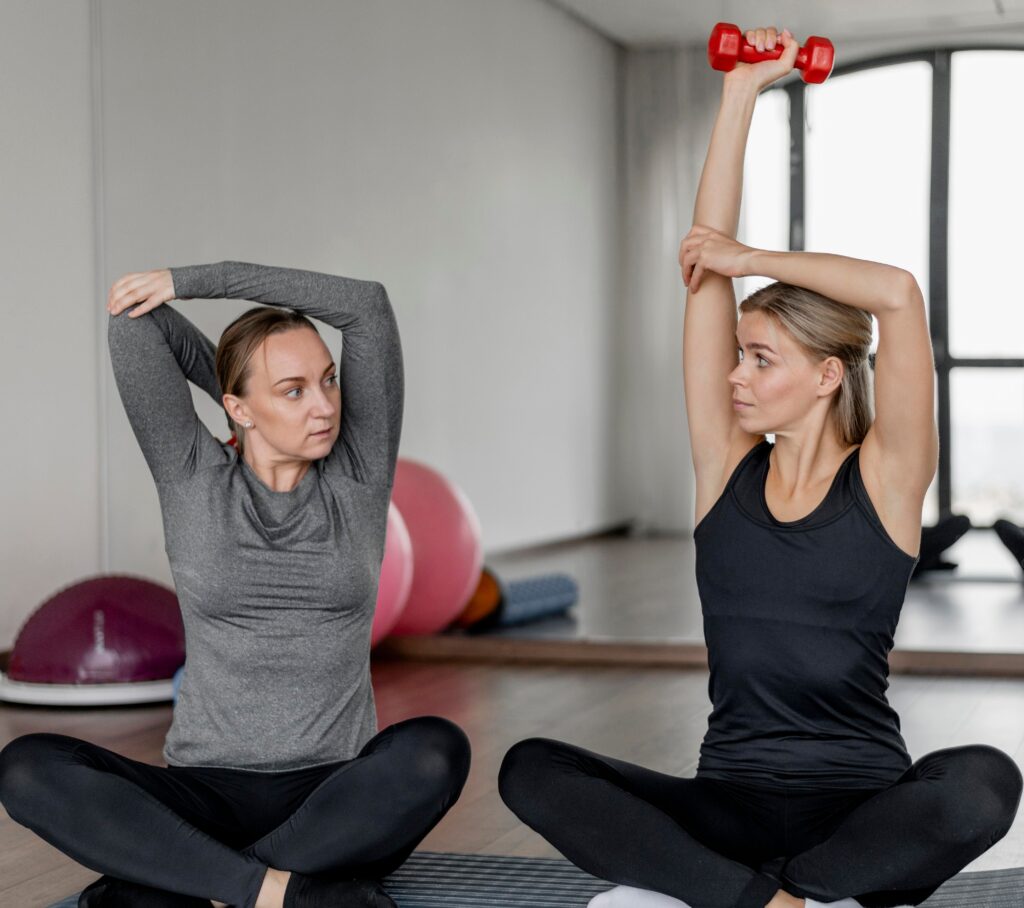Strong and, at the same time, flexible shoulders are significant both for overall fitness and in everyday life. Shoulder exercises not only straighten your posture but also increase sports performance and strength while minimizing potential injuries. This will help you run through almost everything you need to know about working out the shoulders, from the anatomy of the shoulders down to the development of an effective workout routine.

Understanding Shoulder Anatomy
Before getting into Shoulder exercises performed for the shoulders, know that it is useful to know its anatomy first of all. The main muscles, therefore, which are involved in the shoulder movements, are the deltoids, rotator cuff, and trapezius. These muscles act jointly to provide so much flexibility in a wide range, while at the same time providing stability.
Deltoids
The deltoids are your rounded muscles at the top of your shoulders. They are further divided into anterior, lateral, and posterior parts. Each portion has a different function in terms of shoulder movement.
Rotator Cuff
The rotator cuff is a group of four small muscles that keep the shoulder joint stable. They provide rotational movements but also supply some general stability to the shoulder.
Trapezius
The trapezius is a large muscle that runs from neck to mid-back. It supports dynamic shoulders in activity and helps in maintaining good posture.
Why Shoulder Workouts Are Essential
Shoulder workouts are important for many reasons. Good shoulders provide better posture, enhancement of athletic performance, and avoidance of injury. ◎ Flexible shoulders make easy daily activities and avoid potential shoulder pains.
Warm-Up Exercises for Shoulders
One cannot overemphasize warming up before any shoulder workout to avoid injuries and improve performance. Listed here are some effective warm-up exercises for a shoulder workout:
Arm Circles
Arm circles increase blood flow and loosen the shoulder muscles. First, start performing small circles and then gradually increase their size.
Shoulder Shrugs
Shoulder shrugs do a fantastic job of warming up the trapezius muscles. Raise your shoulders towards your ears and then lower them back down.
Dynamic Stretches
Examples of dynamic stretches include arm swings and cross-body arm stretches that loosen up your shoulders before the workout.
Top 10 Shoulder Exercises
Shoulder Press
The shoulder press is another fundamental exercise for building up the strength of the shoulders. It works the deltoids—the triceps and upper chest are secondary movers.
Steps to Perform:
- Stand with feet shoulder-width apart. Dumbbells are held at shoulder height, palms facing forward. Press the weights overhead until the arms are fully extended.
- Lower the weight again to shoulder level.
- Lateral Raises
Lateral raises do a nice job of isolating the lateral deltoids, and they also contribute a great deal toward widening your shoulders.
Steps to Perform:
- Stand with your feet at shoulder width, holding dumbbells at your sides.
- Raise your arms out to your sides until they are at shoulder level.
- Lower the weights back to the starting position.
- Front Raises
Front raises work the anterior deltoids and help develop the front part of your shoulders.
Steps to Perform:
- Stand with your legs at shoulder width apart, holding dumbbells in front of your thighs.
- Raise the weights to shoulder height while keeping your arms straight.
- Lower the weights back into the original position.
- Bent-Over Reverse Fly
Target: Posterior Deltoids and Upper Back; this exercise will provide better overall shoulder stability and posture.
Steps to Perform:
- At the hips, bend down slightly, and then bend your knees with the dumbbells held in your hands with your palms facing each other.
- Extend your arms to the sides until they are level with your shoulders.
- Lower the weights to your starting position.
- Upright Row
A more interesting and effective way to install deltoids and trapezius muscles in your shoulder exercises is with upright rows.
Steps to Perform:
- Stand with your feet shoulder-width apart, holding a barbell with an overhand grip.
- Lift the barbell to chest height with the elbows pointing outward.
- Lower the barbell to the original starting position.
- Arnold Press
Arnold press is one of the shoulder presses that could be able to hit all the parts of the deltoids and exercise them fully.
Steps to Perform:
- Sit or stand with your feet at shoulder-width apart holding dumbbells at shoulder-level height with your palms turned towards you.
- Turn your palms outward when pressing the weights above your head.
- Lower the weight and return to the initial position turning your palm inwards.
- Face Pulls
Face pulls are good exercises to train for overall shoulder health and posture, as they hit the rear delts and upper back.
Steps to Perform:
- Attach a rope to a cable machine at chest height.
- Pull the rope to your face keeping elbows high.
- Slowly return to the original position.
- Push Press
This is quite a dynamic exercise that links shoulder strength with the ability of explosive power.
Steps to Perform:
- Stand with your feet shoulder-width apart, holding a barbell at shoulder height.
- Slightly bend your knees and then extend your legs, driving the barbell overhead.
- Lower the barbell to the starting position.
- External Rotations
The external rotations are done for the strengthening of the rotator cuff muscles, which are crucial in terms of preventing injuries and enhancing the general stability of the shoulder.
Steps to Perform:
- Hold the resistance band attached to an object at your waist level.
- With your elbow at a 90-degree bent, keep the band then rotate your arm outside.
- Return to original.
- Scapular Retractions
It goes a long way to improve the nature of shoulder stability and posture through the muscles surrounding the shoulder blades.
Steps to Perform:
- Stand with your feet at shoulder-width apart, holding the resistance band with an arms extended front.
- Keep on pulling the band apart while squeezing together the shoulder blades.
- Return to the original position. Boot up a well-balanced Shoulder Exercise Routine
Creating a Balanced Shoulder Workout Routine
For maximum output from shoulder exercises, a well-rounded workout routine should be fashioned. This will not only involve strength exercises but also some flexibility and mobility exercises. Here is how one can plan his workouts in a week:
Monday:
- Shoulder Press
- Lateral Raises
- External Rotations
Wednesday:
- Front Raises
- Bent-Over Reverse Fly
- Face Pulls
Friday:
- Upright Row
- Arnold Press
- Scapular Retractions
Preventing Shoulder Injuries
Since the shoulder joint is prone to injury, it is very relevant to prevent these injuries to have long-term health in the shoulders. Here are some tips for preventing these injuries:
- Always warm up before workouts.
- Be sure to focus on proper form and technique.
- Avoid overtraining, and take care that your shoulders get enough rest.
- Incorporate some flexibility and mobility exercises into your workout routine.
Shoulder Workouts for Different Fitness Levels
Beginner Shoulder Workout Plan
- Shoulder Press — 3 sets, 10 reps
- Lateral Raises — 3 sets, 12 reps
- Front Raises — 3 sets, 12 reps
Intermediate Shoulder Workout Routine
- Arnold Press — 3 sets, 10 reps
- Bent-Over Reverse Fly — 3 sets, 12 reps
- Upright Row — 3 sets, 10 reps
Advanced Shoulder Workout Regimen
- Push Press — 3 sets, 8 reps
- Face Pulls: 3 sets of 15 reps
- Scapular Retractions: 3 sets of 15 reps
Incorporating Flexibility and Mobility Exercises
Flexibility and mobility exercises are of equal importance in maintaining the overall well-being of your shoulders. Add the following exercises to help you efficiently increase your range of motion, and prevent the development of any kind of stiffness.
Recommended Exercises:
- Shoulder Stretches: Hold for 20-30 seconds each.
- Dynamic Arm Swings: 1-2 minutes.
- Cross-body arm stretches: Hold for 20-30 seconds each.
Frequently Asked Questions (FAQs)
What are some of the best shoulder exercises to start with?
- Of course, beginner exercises should include the basics, which are shoulder presses, lateral raises, and front raises. Simmer down, focus on proper form, and gradually add weight and intensity.
How often could one do shoulder workouts?
- The frequency of shoulder workouts will depend on individual levels of fitness. Beginners need a workout to be done on the shoulders two times per week, and those at higher levels of fitness may need three to four times per week.
Will I be able to do shoulder exercises without any equipment at home?
- Yes, many types of shoulder exercises can be done without equipment, that is, bodyweight versions—push-ups, pike push-ups, handstand push-ups. You can also use resistance bands for added resistance.
How do I avoid shoulder pain during workouts?
- Avoid shoulder pain with careful warming up, proper form, and not lifting beyond your weight class. Stop the exercise in case of pain, and if needed seek advice from a healthcare professional.
What do I do in case of shoulder pains after my workouts?
- In case of shoulder pain after workouts, rest and ice the area. If it persists, seek medical advice to avoid further injury.
Conclusion
In addition, integrating shoulder exercises that target the shoulders secures strength and flexibility in them but also prevents injuries. You want to get strong and healthy shoulders, so it is through an understanding of shoulder anatomy coupled with this well-rounded workout. Never forget to warm up, pay homage to proper form, and stretch for the best results. Now, start building those shoulders toward the benefit of having both strong and flexible shoulders.












